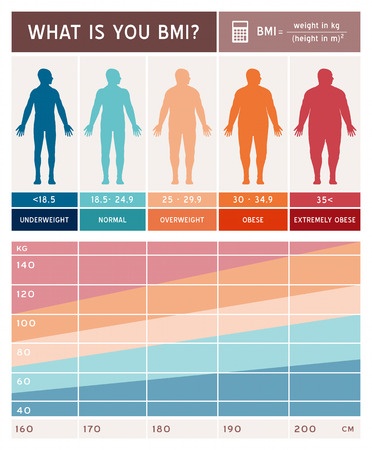
What is a body mass index (BMI)?
Body Mass Index (BMI) is a measurement that compares your height to your weight.
Some charts (like the one offered by the National Institutes of Health) do not differentiate between men and women. There has been a very slow trend among health and wellness professionals using different charts for men and women, and even another chart for people who are athletic and muscular. Since muscle weighs more than fat, a BMI chart may indicate that a very fit person is overweight. In fact, most professional wrestlers, football players, and mixed martial artists would be considered “obese” by most BMI charts.
 The BMI is often used by doctors and health clubs, but it is not the only tool, or even always the most accurate one, to determine if you are overweight, underweight, or in a desirable range.
The BMI is often used by doctors and health clubs, but it is not the only tool, or even always the most accurate one, to determine if you are overweight, underweight, or in a desirable range.
The BMI should only be used as a general guideline. It is important to remember that a “normal” body weight is only part of being healthy. There are people that are “skinny” but still have significant health risks and medical problems due to inactivity, high stress, smoking, or other factors.
Although being overweight does increase your risk for certain problems including high blood pressure, heart attack, stroke, and pre-diabetes, even thin people can develop all these problems, too. Still, losing weight has been shown to reduce the risk of many health problems and can go a long way towards preventing or controlling type 2 diabetes. In women, even losing a modest amount of weight can improve fertility in those that suffer from certain types of infertility like polycystic ovarian syndrome (PCOS).
- Calculate Your BMI Ratio (Free online calculator tool)
- Is the BMI chart accurate for determining if a person is overweight?
Waist-to-Hip Ratio and Pre-Diabetes Risks By Body Type
Waist-to-hip ratio is used to determine a person’s risk for developing pre-diabetes. Your body shape also plays a role in risk factors. All people who are overweight have an increased risk of developing pre-diabetes, and all people age 45 and older, regardless of weight also have an increased risk of becoming pre-diabetic.


People who carry more weight around the waist, chest, and abdomen, have “apple” bodies.
People with apple bodies have a higher risk for developing certain health problems than those with pear shaped bodies. But having a pear shape does not mean that you too, are not at risk.
If you are overweight talk with your doctor about ways to lose weight to reduce your risk of developing pre-diabetes and type 2 diabetes.
People who carry more weight around their hips, thighs, and buttocks have “pear-shaped” bodies.



